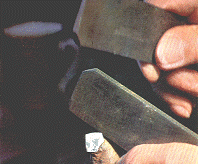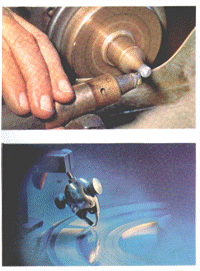
 |
How it works : Diamond |
DIAMOND CUTTING and POLISHING
 |
| Above: cleaving a diamond. A mark called a keri has teen scratched on the stone with another diamond. A metal blade is inserted in the keri and tapped sharply in the direction of the plane of cleavage. |
Rough natural diamonds can be divided into four principal shape categories: stones, cleavages, maccles and flats. Very few diamonds are flawless. Most contain spots and various other types of inclusion, usually carbon, and these may he invisible to the naked eye. The position of flaws, and their size, is important in the cutting of a clean gemstone.
The principal diamond cutting centres are Antwerp, Bombay, New York, Amsterdam and Tel Aviv, but cutting is also carried out in many other countries. Each centre has grown accustomed to cutting a particular category of diamond; Antwerp specializes mainly in cutting cleavages, maccles and chips, the United States in stones, while Amsterdam, Israel and India cut mostly small brilliants.
Although it is the hardest natural substance, a diamond can he shaped and faceted. This is because it has planes of relative weakness, along which, if expertly handled, it can he cleaved cleanly in two. A diamond crystal has hard and soft faces, and on each face there are hard and soft directions. (Relatively speaking, even the soft direction is incredibly hard.) Therefore, if diamonds are crushed, a powder is obtained which can he used to polish other diamonds, since when polishing, many of the particles in the powder present their hard directions to the soft direction of the diamond face being polished.
The four processes used in making a gemstone are cleaving, bruting, sawing and polishing.
Cleaving
Cleaving is used before polishing to obtain an improved shape from an
irregularly shaped stone, or to split the rare large stones into manageable
pieces. A skilled and experienced worker can determine the cleavage plane
direction and then, on an edge which is relatively soft, make a scratch mark,
known as a keri, with the bard edge of another diamond. A metal blade,
with its plane parallel to the cleavage plane, is then inserted in the keri
and tapped sharply with a wooden mallet. If this is done correctly the diamond
will cleave in two.
 |
Top right: bruting a diamond A diamond can be roughly rounded by pressing another diamond against it while it spins in a chuck. |
| Below right: polishing a diamond. Facets are polished by mounting the. stone in a device similar to a record player arm which presents it to the polishing wheel. Diamond polishing powder is used. The operator's skill is essential in presenting the stone correct{y. |
Sawing
Preliminary shaping is often done with a high speed slitting saw, a thin
disc of phosphor-bronze run at about 5000 rpm. The edge of the disc is covered
with a paste of fine diamond dust and olive oil. It is a particularly
useful process when cutting across a cleavage plane.
Bruting
Bruting is a rounding process carried out before polishing. The diamond
to be polished is mounted in a lathe chuck and another diamond pressed against
it as it revolves, roughly rounding it.
Polishing
Diamond powder is rubbed on or impregnated into a cast iron wheel known
as a scaife. The diamond to be polished is mounted in a dop
and tang. The dop is the holder into which the diamond is fixed with
solder, or held mechanically. The tang, acting rather like a record player
arm presents the diamond to the revolving scaife. Because of diamond's
hard and soft directions the correct presentation of the diamond to the wheel
is one of the essential skills of the diamond polisher.
The most widely used cut is the brilliant-cut, which requires 58 separate faceting operations. A large diarnond can take months to polish. Other popular cuts are the Emerald, Oval, Pear and Marquise.
Polishing has been traditionally the craft of the individual. Recently, however, a new machine, The Piermatic, has been developed which automatically polishes diamonds up to a half a carat with great efficiency.
Reproduced from HOW IT WORKS p742